|
|
|
|
|
Oil On
Canvas, Real Flavor of Old Masters
|
|

|
ARTWORKS
INDEX
A B C D E F G H I J K L M N O P Q R S T U V W X Y Z |
ARTISTS
INDEX
A B C D E F G H I J K L M N O P Q R S T U V W X Y Z |
|
|
| | |
|
|
 |
Alf Wallander -- Click Here
|
|
painted Artillerigatan in Winter Dress in 1892 |
|
 |
alexis wetterbergh -- Click Here
|
|
wetterberghs malning bar professor sandbergs godkannande paskrift, men eftersom maleri inte forekom pa konstakademiens schema fore 1856 |
|
 |
Alexis Simon Belle -- Click Here
|
|
(12 January 1674 - 21 November 1734) was a French portrait painter, known for his portraits of the French and Jacobite nobility.
Belle was born in Paris, the second child and only son of Jean-Baptiste Belle (born before 1642, died 1703), also a painter, and of Anne his wife (died 1705).
Belle's birth and baptism are recorded in the parish register of the church of Saint-Sulpice, Paris, and quoted in Eugene Piot's Le Cabinet de l'amateur for the years 1861 and 1862
|
|
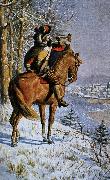 |
alexis de tocqueville -- Click Here
|
|
was born in Paris on July 29, 1805, of an aristocratic Norman family. He studied law in Paris (1823-1826) and then was appointed an assistant magistrate at Versailles (1827).
|
|
 |
Alexey Tyranov -- Click Here
|
|
(Russian,1801 - 3 August 1859) was a Russian painter. Early in his career he painted icons with his brother; he then traveled to St. Petersburg to study at the Academy, where he took lessons with Alexey Venetsianov. From 1836 he was a pupil of Karl Bryullov. Tyranov chiefly painted portraits and genre scenes; he exhibited at a number of venues in the city throughout the 1830s and 40s. |
|
 |
Alexey Gavrilovich Venetsianov -- Click Here
|
|
painted Morning of the land-lady in 1823 |
|
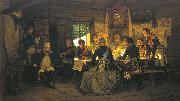 |
Alexey Danilovich Kivshenko -- Click Here
|
|
painted Michail Illarionovich Kutuzov in 1880 |
|
 |
Alexey Bogolyubov -- Click Here
|
|
16 March 1824 - 3 February 1896) was a Russian landscape painter.
Bogolyubov was born in the Pomeranian village of Novgorod Gubernia. His father was retired colonel Pyotr Gavriilovich Bogolyubov. Bogolyubov's maternal grandfather was the well-known philosopher and social critic Alexander Radishchev.
In 1841, Alexey graduated from military school, serving in the Russian Navy and travelling with the fleet to many countries. In 1849, he started to attend classes of the Saint Petersburg Academy of Arts, where he studied under Maxim Vorobiev. The young painter was greatly influenced by Ivan Ayvazovsky. In 1853, he finished the Academy with a major Gold medal. He retired as a navy officer and was appointed an artist to the Navy headquarters.
From 1854 to 1860, he travelled around Europe and worked prolifically. In Rome, he was acquainted with Alexander Ivanov, who convinced Bogolyubov to focus more on drawing. In Desseldorf, Bogolyubov took classes from the painter Andreas Achenbach. In Paris, he admired the artists of the Barbizon School. French painters Camille Corot and Charles François Daubigny were good friends and collaborators with Bogolyubov.
Bogolyubov returned to Russia in 1860. He exhibited his works in the Academy and received the title of professor. For some time, he taught in the Academy. In the 1860s, he traveled along the Volga. His paintings lost all traces of Romanticism, replacing that element with staunch realism of the natural. In 1871 he was elected to the Imperial Academy of Arts.
Sailing ships, 1860From 1870, he became close to the The Wanderers art movement, participated in all their exhibitions. He became a member of their board. Much older than most of the other members of the movement, he had reservations on their social ideas. In 1873, Bogolyubov left the ? in solidarity with his fellow Itinerants. He even tried to create an alternative Russian Academy of Arts in Rome.
|
|
 |
Alexej von Jawlensky -- Click Here
|
|
Alexej Georgewitsch von Jawlensky (13 March 1864 - 15 March 1941) was a Russian expressionist painter active in Germany. He was a key member of the New Munich Artist's Association (Neue Kenstlervereinigung Menchen), Der Blaue Reiter (The Blue Rider) group and later the Die Blaue Vier (The Blue Four).
|
|
 |
alexej von jawlenskij -- Click Here
|
|
Alexej Georgewitsch von Jawlensky (13 March 1864 ?C 15 March 1941) was a Russian expressionist painter active in Germany. He was a key member of the New Munich Artist's Association (Neue Kunstlervereinigung M??nchen), Der Blaue Reiter (The Blue Rider) group and later the Die Blaue Vier (The Blue Four).
Alexej von Jawlensky was born in Torzhok, a town in Tver Governorate, Russia, as the fifth child of Georgi von Jawlensky and his wife Alexandra (n??e Medwedewa). At the age of ten he moved with his family to Moscow. After a few years of military training, he became interested in painting, visiting the Moscow World Exposition circa 1880.
In 1896 he moved to Munich, where he studied in the private school of Anton Ažbe. In Munich he met Wassily Kandinsky and various other Russian artists, and he contributed to the formation of the Neue K??nstlervereinigung M??nchen. His work in this period was lush and richly coloured, but later moved towards abstraction and a simplified, formulaic style.
Alexej von Jawlensky. Abstract Head, c. 1928Von Jawlensky died in Wiesbaden, Germany on 15 March 1941. He and his wife Helene are buried in the cemetery of St. Elizabeth's Church, Wiesbaden. |
|
 |
Alexej Kondratjewitsch Sawrassow -- Click Here
|
|
Alexei Kondratyevich Savrasov (Russian) (May 24, 1830 - October 8, 1897) was a Russian landscape painter and creator of the lyrical landscape style.
Savrasov was born into the family of a merchant. He began to draw early and in 1838 he enrolled as a student of professor Rabus at the Moscow School of Painting, Sculpture and Architecture (graduated in 1850), and immediately began to specialize in landscape painting.
In 1852, he traveled to Ukraine. Then, in 1854 by the invitation of the Grand Duchess Maria Nikolayevna, President of the Imperial Academy of Arts, he moved to the neighborhood of St. Petersburg. In 1857, Savrasov became a teacher at the Moscow School of painting, sculpturing and architecture. His best disciples, Isaac Levitan and Konstantin Korovin, remembered their teacher with admiration and gratitude.
|
|
|
|
|
|
 |
Alexei Savrasov -- Click Here
|
|
Russian Painter, 1830-1897
was a Russian landscape painter and creator of the lyrical landscape style. Savrasov was born into the family of a merchant. He began to draw early and in 1838 he enrolled as a student of professor Rabus at the Moscow School of Painting, Sculpture and Architecture (graduated in 1850), and immediately began to specialize in landscape painting. In 1852, he traveled to Ukraine. Then, in 1854 by the invitation of the Grand Duchess Maria Nikolayevna, President of the Imperial Academy of Arts, he moved to the neighborhood of St. Petersburg. In 1857, Savrasov became a teacher at the Moscow School of painting, sculpturing and architecture. His best disciples, Isaac Levitan and Konstantin Korovin, remembered their teacher with admiration and gratitude. The Rooks Have Come Back was painted by Savrasov near Ipatiev Monastery in Kostroma.In 1857, he married Sophia Karlovna Hertz, sister of art historian K. Hertz. In their home they entertained artistic people and collectors including Pavel Tretyakov. Savrasov became especially close with Vasily Perov. Perov helped him paint the figures of the boat trackers in Savrasov's Volga near Yuryevets, Savrasov painted landscapes for Perov's Bird catcher and Hunters on Bivouac. In the 1860s, he traveled to England to see the International Exhibition, and to Switzerland. In one of his letters he wrote that no academies in the world could so advance an artist as the present world exhibition. The painters who influenced him most were British painter John Constable and Swiss painter Alexandre Calame. The Rooks Have Come Back (1871) is considered by many critics to be the high point in Savrasoves artistic career. Using a common, even trivial, episode of birds returning home, and an extremely simple landscape, Savrasov emotionally showed the transition of nature from winter to spring. It was a new type of lyrical landscape painting, called later by critics the mood landscape. The painting brought him fame. In 1870, he became a member of the Peredvizhniki group, breaking with government-sponsored academic art. In 1871, |
|
 |
Alexei Korzukhin -- Click Here
|
|
(1835-1894) was Russian painter. A Korzukhin 000.JPG
Korzukhin was born in Yekaterinburg on March 23, 1835. In 1858 he began his studies in the St. Petersburg in the Imperial Academy of Arts. In 1860, Korzukhin won his first award for the painting his The Drunken Father.
In 1864, he help found Petersburg Artel of Artists - the "Revolt of Fourteen". Korzukhin has received a rank of the artist of the First Degree for his painting Commemoration on a Rural Cemetery (1865). For The Return of the Father from Fair, he received a rank of the academician. In 1870, he became a founding member of the art group 'The Wanderers.
In 1891 he painted The Lord's Supper for a cathedral in Riga. Korzukhin is perhaps most famous for his many portraits, each of which is characterized to have a subtle psychological depth. For this reason they are generally accepted as masterpieces of Russian portrait painting.
Alexei Korzukhin died in St. Petersburg on October 30, 1894.
|
|
 |
Alexei Jawlensky -- Click Here
|
|
1864-1941
Russian
Alexei Jawlensky Galleries
Alexej von Jawlensky was born in Torzhok, a town in the department of Tver, Russia, as the fifth child of Georgi von Jawlensky and his wife Alexandra (n??e Medwedewa). His family was aristocratic.
At the age of ten he moved with his family to Moscow. After a few years of military training, he became interested in painting, visiting the Moscow World Exposition c. in 1880.
In 1896 he moved to Munich where he studied in the private school of Anton Azbe. In Munich he met Wassily Kandinsky, and Marianne von Werefkin, other Russian artists and helped form the Neue Kunstlervereinigung M??nchen. His work in this period was lush and richly coloured, but later moved towards abstraction with a simplified and formulaic style in a search to find the spiritual.
Alexej von Jawlensky. Abstract Head, c. 1928He died in Wiesbaden, Germany on 15 March 1941. |
|
 |
Alexei Harlamov -- Click Here
|
|
(or Alexej Harlamoff - Alexej Charlamoff) (1840-1925) was a Russian painter.
Harlamoff paintings are signed "Harlamoff", which may be a translation he learned while studying in Paris. This does not translate into the Russian language from English. |
|
|
|
 |
Alexandre-Gabriel Decamps -- Click Here
|
|
(March 3, 1803 - August 22, 1860) was a French painter.
He was born in Paris. In his youth he travelled in the East, and reproduced Oriental life and scenery with a bold fidelity to nature that puzzled conventional critics. His powers, however, soon came to be recognized, and he was ranked along with Delacroix and Vernet as one of the leaders of the French school. At the Paris Exhibition of 1855 he received the grand or council medal. Most of his life was passed in the neighborhood of Paris. He was fond of animals, especially dogs, and indulged in all kinds of field sports. He died in 1860 in consequence of being thrown from a horse while hunting at Fontainebleau.
Decamps' style was characteristically and intensely French. It was marked by vivid dramatic conception, bold and even rough brushstrokes, and startling contrasts of color and of light and shade. His subjects embraced an unusually wide range. He availed himself of his travels in the East in dealing with scenes from Scripture history, which he was probably the first of European painters to represent with their true and natural local background. Of this class were his Joseph sold by his Brethren, Moses taken from the Nile, and his scenes from the life of Samson, nine vigorous sketches in charcoal and white.
Perhaps the most impressive of his historical pictures is Defeat of the Cimbri, representing the conflict between a horde of barbarians and a disciplined army. Decamps produced a number of genre pictures, chiefly scenes from French and Algerian domestic life, the most marked feature of which is humour. The same characteristic attaches to many of his numerous animal paintings; Decamps was especially fond of painting monkeys. His well-known painting The Monkey Connoisseurs satirizes the jury of the French Academy of Painting, which had rejected several of his earlier works on account of their divergence from any known standard. |
|
|
|
Alexandre-Francois Caminade -- Click Here
|
|
Alexandre-Francois Caminade (December 14, 1783 - May 1862) was a French painter.
Caminade was born and died in Paris. He was a portraitist and a religious painter. He was Jacques Louis David's pupil. See also, Larousse article at Cyclopedia of Painters and Paintings, eds. John Desnison Champlin and Charles Callahan Perkins |
|
 |
Alexandre-Evariste Fragonard -- Click Here
|
|
French Painter, 1780-1850,son of Jean-Honore Fragonard, was a French painter and sculptor in the troubadour style. He received his first training from his father and drew from him his piquant subjects and great facility, perfecting them under David. |
|
 |
Alexandre-Denis Abel de Pujol -- Click Here
|
|
French, 1787-1861 |
|
 |
Alexandre Seon -- Click Here
|
|
French Symbolist Painter, 1855-1917
was a French Symbolist artist, illustrator and decorator. Seon studied at the Beaux-Arts of Lyon and Paris, becoming a student of Puvis de Chavannes in 1891, with whom he later collaborated. He was closely associated with Josephin Peladan and his Salon de la Rose-Croix, and designed the frontispiece for Peladan's 1891 novel l'Androgyne |
|
|
|
 |
Alexandre Rachmiel -- Click Here
|
|
painted Autumn Landscape in 1890 |
|
 |
Alexandre N. Roussoff -- Click Here
|
|
Russian, 1844 - 1928 |
|
 |
Alexandre Keirincx -- Click Here
|
|
1600-1652
Flemish
Alexandre Keirincx Gallery
|
|
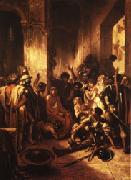 |
Alexandre Gabriel Decamps -- Click Here
|
|
French Romantic Painter, 1803-1860.
Studied under Abel de Pujol.
Specializes in Orientalism.
Studied under Abel de Pujol. Specializes in Orientalism. French genre and historical painter, engraver, and lithographer. First known for his caricatures and illustrations, he turned to painting in thick impasto and strong color. One of his richest sources was the Middle East, which he depicted in vivid detail. |
|
 |
Alexandre Defaux -- Click Here
|
|
(1826-1900) was a French artist. He was born in Bercy and studied under Jean-Baptiste Camille Corot. He was a member of the Barbizon School.
|
|
|
|
 |
Alexandre Calame -- Click Here
|
|
1810-1864
French Alexandre Calame Locations
Swiss painter, draughtsman and printmaker. He studied under Francois Diday in Geneva and then travelled to Paris (1837), to the Netherlands and Desseldorf (1838), to Italy (1844) and to London (1850). Despite his frail health he spent each summer painting in the mountains of the Bernese Oberland and central Switzerland, where he produced the drawings and studies from nature that were later used in his studio compositions. A fervent Calvinist, he saw his subjects. |
|
 |
Alexandre Cabanel -- Click Here
|
|
French Academic Painter, 1823-1889
French painter and teacher. His skill in drawing was apparently evident by the age of 11. His father could not afford his training, but in 1839 his departement gave him a grant to go to Paris. This enabled him to register at the Ecole des Beaux-Arts the following October as a pupil of Franeois-Edouard Picot. At his first Salon in 1843 he presented Agony in the Garden (Valenciennes, Mus. B.-A.) and won second place in the Prix de Rome competition (after Leon B?nouville, also a pupil of Picot) in 1845 with Christ at the Praetorium (Paris, Ecole N. Sup. B.-A.). Both Cabanel and Benouville were able to go to Rome, as there was a vacancy from the previous year. Cabanel's Death of Moses (untraced), an academic composition, painted to comply with the regulations of the Ecole de Rome, was exhibited at the Salon of 1852. |
|
 |
Alexandre Cabanel -- Click Here
|
|
1823-1889
French Alexandre Cabanel Locations
French painter and teacher. His skill in drawing was apparently evident by the age of 11. His father could not afford his training, but in 1839 his departement gave him a grant to go to Paris. This enabled him to register at the Ecole des Beaux-Arts the following October as a pupil of Francois-Edouard Picot. At his first Salon in 1843 he presented Agony in the Garden (Valenciennes, Mus. B.-A.) and won second place in the Prix de Rome competition (after Lon Benouville, also a pupil of Picot) in 1845 with Christ at the Praetorium (Paris, Ecole N. Sup. B.-A.). Both Cabanel and Benouville were able to go to Rome, as there was a vacancy from the previous year. Cabanel Death of Moses (untraced), an academic composition, painted to comply with the regulations of the Ecole de Rome, was exhibited at the Salon of 1852. The pictures he painted for Alfred Bruyas, his chief patron at this time (and, like Cabanel, a native of Montpellier), showed more clearly the direction his art had taken during his stay in Italy. Albayde, Angel of the Evening, Chiarruccia and Velleda (all in Montpellier, Mus. Fabre) were the first of many mysterious or tragic heroines painted by Cabanel and show his taste for the elegiac types and suave finish of the Florentine Mannerists. |
|
|
|
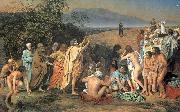 |
Alexandr Andreevich Ivanov -- Click Here
|
|
painted Appearance of Christ to the People in 1837 |
|
 |
Alexander Young Jackson -- Click Here
|
|
(October 3, 1882 - April 5, 1974) was a Canadian painter and a founding member of the Group of Seven.
As a young boy, Jackson worked as an office boy for a lithograph company, after his father abandoned his family of six children. It was at this company that Jackson began his art training. In the evenings, he took classes at Montreal's Monument-National
In 1905, Jackson worked his way to Europe on a cattle boat, returning by the same means and travelling on to Chicago. In Chicago, he joined a commercial art firm and took courses at the Art Institute of Chicago. He saved his earnings and, by 1907, was able to visit France to study Impressionism. In France, Jackson decided to become a professional painter, studying at Paris' Academie Julian under J.P. Laurens.
|
|
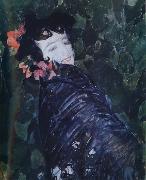 |
Alexander Yakovlevich GOLOVIN -- Click Here
|
|
an important Russian artist and stage designer who designed sets for many productions by Sergei Diaghilev,1863-1930 |
|
 |
Alexander Wilson -- Click Here
|
|
Alexander Wilson (July 6, 1766 - August 23, 1813) was a Scottish-American poet, ornithologist, naturalist, and illustrator.
Wilson was born in Paisley, Scotland, the son of an illiterate distiller. In 1779 he was apprenticed as a weaver. His main interest at this time was in writing poetry (Robert Burns was seven years older than Wilson). Some of Wilson's work - commenting on the unfair treatment of the weavers by their employers - got him into trouble with the authorities. The "golden age of Renfrewshire song" is embodied in the persons of Wilson and Robert Tannahill. Alexander Wilson was born near the Hammils, a broad if not steep waterfall in Paisley where the River Cart skirts Seedhill. It does indeed appear to be the case, as William Motherwell states, that a great amount of literary activity began in Paisley around this time.
Illustration from
"An American ornithologyIn May 1794 Wilson left Scotland with his nephew to find a better life in America. Wilson obtained employment as a schoolteacher in Milestown, near Philadelphia. In 1801 he left Milestown and found a new teaching post in Gray's Ferry, Pennsylvania; Wilson took up residence in nearby Kingsessing. It was here that he met the famous naturalist William Bartram who developed Wilson's interest in ornithology. In 1802 Wilson decided to publish a book illustrating all the North American birds. With this in mind he traveled widely, watching and painting birds and collecting subscribers for his book. The result was the nine-volume American Ornithology (1808-1814), illustrating 268 species of birds, 26 of which had not previously been described. He died during the writing of the ninth volume, which was completed and published after his death by his friend George Ord. Wilson lies buried next to Ord at Gloria Dei Church cemetery in Philadelphia, Pennsylvania. |
|
|
|
 |
Alexander von Wagner -- Click Here
|
|
German/Hungarian, 1838-1919 |
|
 |
Alexander von Humboldt -- Click Here
|
|
Berlin 1769-1859 Berlin,was a German naturalist and explorer, and the younger brother of the Prussian minister, philosopher, and linguist Wilhelm von Humboldt (1767-1835). Humboldt's quantitative work on botanical geography was foundational to the field of biogeography. Between 1799 and 1804, Humboldt travelled to Latin America, exploring and describing it from a scientific point of view for the first time. His description of the journey was written up and published in an enormous set of volumes over 21 years. He was one of the first to propose that the lands bordering the Atlantic were once joined (South America and Africa in particular). Later, his five-volume work Kosmos (1845) attempted to unify the various branches of scientific knowledge. |
|
 |
Alexander Theobald Van Laer -- Click Here
|
|
Alexander Theobald Van Laer (1857-1920) was an American painter, born at Auburn, New York.
He studied at the Art Students League of New York |
|
 |
Alexander Roslin -- Click Here
|
|
1718--93
Swedish painter and pastellist, active in Germany and France. He trained with Lars Ehrenbill (1697-1747), a draughtsman employed by the Admiralty in Malmö, and in Stockholm under Georg Engelhardt Schräder (1684-1750), a portrait painter working in the tradition of Hyacinthe Rigaud and Nicolas de Largillierre. In 1741 Roslin moved to Göteborg, but the following year he returned to Malmö, where he executed devotional works for the parish church of Hasslöv, Halland, and began establishing himself as a portrait painter. |
|
 |
Alexander Pope -- Click Here
|
|
(21 May 1688 - 30 May 1744) was an eighteenth-century English poet, best known for his satirical verse and for his translation of Homer. He is the third most frequently quoted writer in The Oxford Dictionary of Quotations, after Shakespeare and Tennyson. Pope is famous for his use of the heroic couplet.
Pope was born to Edith Pope (1643-1733) and Alexander Pope Senior. (1646-1717) a linen merchant of Plough Court, Lombard Street, London, who were both Catholics. Pope's education was affected by the penal law in force at the time upholding the status of the established Church of England, which banned Catholics from teaching, attending a university, voting, or holding public office on pain of perpetual imprisonment. Pope was taught to read by his aunt, then went to Twyford School in about 1698-9. He then went to two Catholic schools in London. Such schools, while illegal, were tolerated in some areas.
In 1700, his family moved to a small estate at Popeswood in Binfield, Berkshire, close to the royal Windsor Forest. This was due to strong anti-Catholic sentiment and a statute preventing Catholics from living within 10 miles (16 km) of either London or Westminster. Pope would later describe the countryside around the house in his poem Windsor Forest. Pope's formal education ended at this time, and from then on he mostly educated himself by reading the works of classical writers such as the satirists Horace and Juvenal, the epic poets Homer and Virgil, as well as English authors such as Geoffrey Chaucer, William Shakespeare and John Dryden. He also studied many languages and read works by English, French, Italian, Latin, and Greek poets. After five years of study, Pope came into contact with figures from the London literary society such as William Wycherley, William Congreve, Samuel Garth, William Trumbull, and William Walsh.
At Binfield, he also began to make many important friends. One of them, John Caryll (the future dedicatee of The Rape of the Lock), was twenty years older than the poet and had made many acquaintances in the London literary world. He introduced the young Pope to the aging playwright William Wycherley and to William Walsh, a minor poet, who helped Pope revise his first major work, The Pastorals. He also met the Blount sisters, Teresa and (his alleged future lover) Martha, both of whom would remain lifelong friends.
From the age of 12, he suffered numerous health problems, such as Pott's disease (a form of tuberculosis that affects the bone) which deformed his body and stunted his growth, leaving him with a severe hunchback. His tuberculosis infection caused other health problems including respiratory difficulties, high fevers, inflamed eyes, and abdominal pain. He never grew beyond 1.37 m (4 ft 6 in) tall. Pope was already removed from society because he was Catholic; his poor health only alienated him further. Although he never married, he had many female friends to whom he wrote witty letters. He did have one alleged lover, |
|
 |
Alexander Nasmyth -- Click Here
|
|
Scottish Painter,
1758-1840
was a Scottish portrait and landscape painter, often called the father of Scottish landscape painting". Edinburgh Castle and Nor'Loch, circa 1780.Born in Edinburgh, he studied at the Royal High School and the Trustees Academy under Alexander Runciman, and, having been apprenticed as an heraldic painter to a coachbuilder, he, at the age of sixteen, attracted the attention of Allan Ramsay, who took the youth with him to London, and employed him upon the subordinate portions of his works. Nasmyth returned to Edinburgh in 1778, and was soon largely patronized as a portrait painter. He also assisted Mr Miller of Dalswinton, as draughtsman, in his mechanical researches and experiments; and, this gentleman having generously offered the painter a loan to enable him to pursue his studies abroad, he left in 1782 for Italy, where he remained two years. Robert Burns, 1787.On his return he painted the excellent portrait of Robert Burns, now in the Scottish National Gallery, well known through Walker's engraving. Political feeling at that time ran high in Edinburgh, and Nasmyth's pronounced Liberal opinions, which he was too outspoken and sincere to disguise, gave offence to many of his aristocratic patrons, and led to the diminution of his practice as a portraitist. In his later years, accordingly, he devoted himself mainly to landscape work, and did not disdain on occasion to set his hand to scene-painting for the theatres. He has been styled, not unjustly, the father of Scottish landscape arte His subjects are carefully finished and coloured, but are wanting in boldness and freedom. |
|
 |
Alexander Mark Rossi -- Click Here
|
|
fl.1870-1903,the British Victorian artist
|
|
 |
Alexander Mann -- Click Here
|
|
Alexander Mann (January 22, 1853 - January 26, 1908) was a Scottish landscape and genre painter. He was a member of New English Art Club and Royal Institute of Oil Painters.
Alexander Mann was born in Glasgow, Scotland on January 22, 1853. He died in London on January 26, 1908.
The second son of James Mann, merchant and collector, he took drawing lessons from the age of ten with Robert Greenlees (1820-94) and then attended evening classes at the Glasgow School of Art, where Greenlees was headmaster.
In 1877 he went to Paris and enrolled at the Academie Julian, and then studied under Mihely Munk? - sy and from 1881 to 1885 under Carolus-Duran. From 1883-93 Mann exhibited in London at the Royal Academy, Royal Institute of Oil Painters, Fine Art Society, New Gallery, Ridley Art Club, New English Art Club and Society of British Artists, a society that appointed James McNeill Whistler its President in 1886. At the same year he was invited to become the first Scottish member of the New English Art Club and was joined by several of his friends, notably John Lavery, Thomas Millie Dow of the Glasgow Boys and Norman Garstin.
Influenced by the Hague school and by Jules Bastien-Lepage, his picture A Bead Stringer, Venice gained an honorable mention at the Salon in 1885. After a public controversy over this painting when it was exhibited at the Royal Glasgow Institute, Mann settled in England, at West Hagbourne, Berkshire, and later in the neighboring village of Blewbury, where he painted a series of views of the Downs and portraits of country people. Mann traveled extensively in Britain, paying several visits to the coast in Angus and Fife, and to Walberswick, Suffolk. |
|
|
|
 |
Alexander Kucharsky -- Click Here
|
|
Alexander Kucharsky (18 March 1741 - 5 November 1819) also Alexandre Kucharsky, was a Polish portrait painter who spent his adult life in France. He himself used the spelling Kucharsky, but Kucharski is also often used. In the past, in France, the name has been given as Couaski. |
|
 |
Alexander Keirincx -- Click Here
|
|
Alexander Keirincx (Antwerp, 23 January 1600-Amsterdam, 1652) was a Flemish Baroque painter who spent his later career in the Dutch Republic. He became a master in Antwerp's guild of St. Luke in 1619, and like his teacher Abraham Govaerts he initially specialized in small cabinet-sized forest landscapes in the manner of Jan Brueghel the Elder and Gillis van Coninxloo. Also like Govaerts, Keirincx's early works typically show diminutive history, mythological or biblical subjects within a Mannerist three-color universal landscape bracketed by repoussoir trees. However, during the 1620s his landscapes become increasingly natural. He lived in Utrecht and Amsterdam from 1628 until the end of his career, and made trips to England to decorate palaces for Charles I. The figures in his works were usually painted by collaborators such as Cornelis Poelenburg.[1] Keirincx worked primarily as an art dealer later in life. |
|
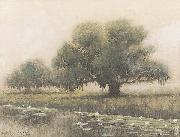 |
Alexander John Drysdale -- Click Here
|
|
painted Louisiana Live Oaks Audubon Park in |
|
 |
Alexander Ivanov -- Click Here
|
|
1806-1858
Russian Alexander Ivanov Galleries
was a Russian painter who adhered to the waning tradition of Neoclassicism but found little sympathy with his contemporaries.
Ivanov studied together with Karl Briullov at the Imperial Academy of Arts under his father, Andrey A. Ivanov. He spent most of his life in Rome where he befriended Gogol and succumbed to the influence of the Nazarenes. He has been called the master of one work, for it took 20 years to complete his magnum opus, The Appearance of Christ before the People (1837-57).
It was for the next generation of art critics to do him justice. Some of the numerous sketches he had prepared for The Appearance have been recognized as masterpieces in their own right. Although Ivanov's major painting is a gem of the Tretyakov Gallery, the most comprehensive collection of his works can be viewed at the Russian Museum in St Petersburg. |
|
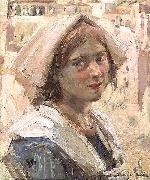 |
Alexander Ignatius Roche -- Click Here
|
|
painted Italian Peasant Girl in 1861-1921 |
|
 |
Alexander Hugo Bakker Korff -- Click Here
|
|
painted An Afternoon Nap in 1866 |
|
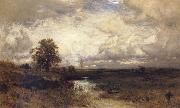 |
Alexander Helwig Wyant -- Click Here
|
|
American Tonalist Painter, 1836-1892,American painter. He began as an itinerant painter of topographical landscapes along the banks of the Ohio River c. 1854, influenced by such landscape artists as Worthington Whittredge and George Inness. In 1863-4 Wyant moved to New York, where he was impressed by the paintings of the Norwegian artist Hans Gude in the Desseldorf Gallery. This led him to work with Gude in Karlsruhe, Germany, in 1865. On his way both there and back, he studied paintings by Constable and used a more painterly technique especially for views of Ireland. |
|
|
|
|
|
 |
Alexander Coosemans -- Click Here
|
|
(1627, Antwerp - 1689, Antwerp), was a Flemish Baroque painter.
According to the RKD he was registered as a pupil of Jan Davidsz de Heem in 1641 and in 1645 he became a master in the Guild of St. Luke.He travelled to Rome in 1649 but was back in Antwerp in 1651. He painted flowers, fruit, and inanimate subjects, and flourished in the Netherlands about 1630. Fruit subjects by him are in the Augsburg Gallery and the Belvedere at Vienna. In the Madrid Gallery there is a fruit-piece attributed to a J. D. Cooseman, who is said to have flourished in the Netherlands in the 17th century: and in the Bordeaux Museum, a fruit-piece ascribed to a N. Coosman. He was followed by Hendrik Schoock. |
|
|
|
 |
Alexander Adriaenssen -- Click Here
|
|
Flemish Baroque Era Painter, 1587-1661
Flemish painter. He was the son of the composer Emanuel Adriaenssen and brother to the painters Vincent Adriaenssen (1595-1675) and Niclaes Adriaenssen (1598-1648/9). In 1597 he was apprenticed to Artus van Laeck (d 1616) and in 1610 became a master in the painters' guild. In 1632 he took on Philips Milcx as apprentice, and in 1635 he painted the coats of arms of the 17 provinces on the triumphal arches in honour of the new governor. Adriaenssen's many signed and often dated oil paintings on wood and canvas are all still-lifes, mainly of food on tables with copper- and tinware, glass and pottery (e.g. Still-life with Fish, 1660; Amsterdam, Rijksmus.). There are four paintings of vases of flowers, but vases of flowers, as well as single flowers on the table, also appear in other still-life combinations. Only two canvases are known in which he worked with figure painters: a garland of flowers around a painting of the Holy Family (Ghent, Paul Boterdaele priv. col.) by Simon de Vos and a porcelain bowl of fruit beside a Virgin and Child (ex-Gal. 'Den Tijd', Antwerp, 1982) attributed to a follower of Rubens. His compositions are graceful and balanced but somewhat stereotyped, and they are bathed in a soft chiaroscuro. |
|
 |
Alexander -- Click Here
|
|
Flemish painter (1587-1661) |
|
 |
Alesso Baldovinetti -- Click Here
|
|
(October 14, 1427??August 29, 1499) was an Italian early Renaissance painter.
Baldovinetti was born in Florence to a family of a rich merchant. In 1448 he was registered as a member of the Guild of St. Luke: "Alesso di Baldovinetti, dipintore."
He was a follower of the group of scientific realists and naturalists in art which included Andrea del Castagno, Paolo Uccello and Domenico Veneziano. Tradition says that he assisted in the decorations of the church of S. Egidio, however no records confirm this. These decoration were carried out during the years 1441 - 1451 by Domenico Veneziano and in conjunction with Andrea del Castagno. That he was commissioned to complete the series at a later date (1460) is certain.
In 1462 Alesso was employed to paint the great fresco of the Annunciation in the cloister of the Annunziata basilica. The remains as we see them give evidence of the artist's power both of imitating natural detail with minute fidelity and of spacing his figures in a landscape with a large sense of air and distance; and they amply verify two separate statements of Vasari concerning him: that "he delighted in drawing landscapes from nature exactly as they are, whence we see in his paintings rivers; bridges, rocks, plants, fruits, roads, fields, cities, exercise grounds, and an infinity of other such things," and that he was an inveterate experimentalist in technical matters.
His favourite method in wall-painting was to lay in his compositions in fresco and finish them a secco with a mixture of yolk of egg and liquid varnish. This, says Vasari, was with the view of protecting the painting from damp; but in course of time the parts executed with this vehicle scaled away, so that the great secret he hoped to have discovered turned out a failure. In 1463 he furnished a cartoon of the Nativity, which was executed in tarsia by Giuliano de Maiano in the sacristy of the cathedral and still exists. From 1466 date the groups of four Evangelists and four Fathers of the Church in fresco, together with the Annunciation on an oblong panel, which still decorate the Portuguese chapel in the basilica of San Miniato, and are given in error by Vasari to Piero Pollaiuolo. A fresco of the risen Christ between angels inside a Holy Sepulchre in the chapel of the Rucellai family, also still existing, belongs to 1467.
In 1471 Alesso undertook important works for tile church of Santa Tr??nita on the commission of Bongianni Gianfigliazzi. First, to paint an altar-piece of the Virgin and Child with six saints; this was finished in 1472: next, a series of frescoes from the Old Testament which was to be completed according to contract within five years, but actually remained on hand for fully sixteen. In 1497 the finished series, which contained many portraits of leading Florentine citizens, was valued at a thousand gold forms by a committee consisting of Cosimo Rosselli, Benozzo Gozzoli, Perugino and Filippino Lippi; only some defaced fragments of it now remain. |
|
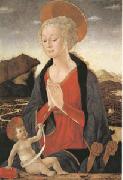 |
Alessio Baldovinetti -- Click Here
|
|
Florence ca 1425-1499 |
|
 |
Alessandro Turchi -- Click Here
|
|
(1578 - 22 January 1649) was an Italian painter of the early Baroque, born and active mainly in Verona, and moving late in life to Rome. He also went by the name Alessandro Veronese or the nickname L'Obetto.
Turchi initially trained with Felice Riccio (il Brusasorci) in Verona. By 1603, he is already working as independent painter, and in 1606-1609, Turchi paints the organ shutters for the Filarmonica Academy of Verona. When Brusasorci dies in 1605, Turchi and his fellow Paschal Ottino (or Pasquale) complete a series of their deceased master's canvases. In 1610, he completes an Assumption altarpiece for the church of San Luca of Verona In 1612, the Veronese Guild of the Goldsmiths commissions an altarpiece, today lost, of the Madonna and Saints. On leaving the school of Riccio, he went to Venice, where he worked for a time under Curio Cagliari.
|
|
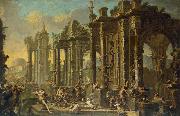 |
Alessandro Magnasco -- Click Here
|
|
(February 4, 1667 - March 12, 1749), also known as il Lissandrino, was an Italian Rococo painter from Northern Italy. He is best known for stylized, fantastic, often phantasmagoric genre or landscape scenes.
|
|
 |
Alessandro Longhi -- Click Here
|
|
1733-1813
Italian
Alessandro Longhi Gallery
Alessandro Longhi (1733-1813) was a Venetian portrait painter and printmaker in etching (mostly reproductions of paintings). He is known best for his oil portraits of Venetian nobles of state. His father was the famed genre painter Pietro Longhi. He trained under his father and Giuseppe Nogari (1609-1763). Like Sebastiano Bombelli in the prior century, Alessandro Longhi is noted for his zealous full-length depicitions of robes and emblems of office. His "tumultuous and unusual (etching) technique shows first-hand knowledge of Rembrandt's etchings", according to Olimpia Theodoli. |
|
 |
Alessandro Filipepe called botticelli -- Click Here
|
|
Florence ca 1445-1510 |
|
 |
Alessandro Botticelli -- Click Here
|
|
Florence ca.1445-1510
Italian painter and draughtsman. In his lifetime he was one of the most esteemed painters in Italy, enjoying the patronage of the leading families of Florence, in particular the Medici and their banking clients. He was summoned to take part in the decoration of the Sistine Chapel in Rome, was highly commended by diplomatic agents to Ludovico Sforza in Milan and Isabella d'Este in Mantua and also received enthusiastic praise from the famous mathematician Luca Pacioli and the humanist poet Ugolino Verino. By the time of his death, however, Botticelli's reputation was already waning. He was overshadowed first by the advent of what Vasari called the maniera devota, a new style by Perugino, Francesco Francia and the young Raphael, whose new and humanly affective sentiment, infused atmospheric effects and sweet colourism took Italy by storm; |
|
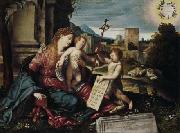 |
Alessandro Bonvicino -- Click Here
|
|
(c. 1498 - December 22, 1554), more commonly known as Il Moretto da Brescia, was an Italian Renaissance painter of Brescia and Venice.
He was born at Rovato, in Brescian territory, and studied first under Fioravante Ferramola. Others state he trained with Vincenzo Foppa. His brothers Pietro and Jacopo were also painters. The 1911 Britannica claims he apprenticed with Titian in Venice and that Moretto modelled his earlier portrait-painting style on the Venetian style. On the other hand, the style also resembles that of Giorgione or late Bellini. The 1911 Britannica also states that he conceived a great enthusiasm for Raphael, though he never traveled to Rome; on the other hand, his classical serenity resembles that shown by Leonardo and his followers in Lombardy such as, for example, Bramantino. He may have consulted with his contemporary Girolamo Savoldo.
Moretto excelled more in sedate altarpieces than in narrative action, and more in oil-painting than in fresco, although he painted fine frescoes depicting the lollygagging daughters of Count Martinengo in one of the palaces near Brescia. In 1521, he worked with Girolamo Romanino in the Cappella del Sacramento in the old cathedral of Brescia, where Moretto completed a Last Supper, Elijah in the Desert, and a Fall of Manna.He was active during 1522-24 in Padua.
He painted alongside with Lorenzo Lotto at Santa Maria Maggiore in Brescia. Also in Brescia, he completed a Five Virgin Martyrs and his masterpiece, the Assumption of the Madonna for the church of San Clemente; a Coronation of the Madonna with four saints (c. 1525) for the church of Santi Nazaro e Celso; a St. Joseph for Santa Maria della Grazie; and a St Nicholas of Ban for Santa Maria de Miracoli. He collaborated with Floriano Ferramola in the decoration of the dome of the cathedral in Brescia.
|
|
 |
Alessandro Allori -- Click Here
|
|
(May 3, 1535 - September 22, 1607) was an Italian portrait painter of the late Mannerist Florentine school.
Born in Florence, in 1540, after the death of his father, he was brought up and trained in art by a close friend, often referred to as his 'uncle', the mannerist painter Agnolo Bronzino, whose name he sometimes assumed in his pictures. In some ways, Allori is the last of the line of prominent Florentine painters, of generally undiluted Tuscan artistic heritage: Andrea del Sarto worked with Fra Bartolomeo (as well as Leonardo Da Vinci), Pontormo briefly worked under Andrea, and trained Bronzino, who trained Allori. Subsequent generations in the city would be strongly influenced by the tide of Baroque styles pre-eminent in other parts of Italy. |
|
 |
Aleksey Korin -- Click Here
|
|
Korin Alexey (1865-1923) -
brief biography
Alexey Korin was born in 1865.
The main themes of his painting were Russian lanscapes, genre-scenes, portraits, interiors.
Studied at the Moscvow School of Painting, Sculpture and Architecture in 1884-1889. Gradueted from this school with big silver medal.
Was the member and took part at the exhebitions of the The Association of Traveling Art Exhibitions (the Itinerants group) since 1891.
Teached at the Moscow School of Painting, Sculpture and Architecture since 1894.
Took part at the World Art Exhibition in Paris in 1900.
Some of the paintings of Alexey Korin were bought by Pavel Tretyakov for his collection. |
|
 |
Aleksey Antropov -- Click Here
|
|
(Russian: 25 March [O.S. 14 March] 1716 - 23 June [O.S. 12 June] 1795) was a Russian barocco painter active primarily in St. Petersburg, where he was born and died. He also worked in Moscow and frescoed churches in Kiev. His preferred medium was oil, but he also painted miniatures and icons.
Alexei was born to a family of government official working in Armory and in the Department of Building (kantselyatiya stroeniy). Since 1732 Alexei also working at the same department under his relative A. Matveyev, since 1739 he is a member of the painting team (zhivopisnaja komanda) of the Department under Ivan Vishnyakov. As the member of the team Alexei took part in fresoeing of Summer Palace, Winter Palace, Anichkov Palace and other buildings of Saint Petersburg. He also studied portrait art from the court painter Louis Caravaque of France. In 1749 Alexei received the rank of the Painter's apprentice (zhivopisniy podmasterye) and in the end of 1750ies the rank of the Master Painter (zhivopisniy master).
In 1752-1755 he worked on the interiors of the St Andrew's Church of Kiev. He supervised the installation of the iconostasis, frescoed cupolas and walls. The most prominent of his frescoes in the church is the Last Supper in the altar.
He started to paint portraits before his Kiev period. The earliest known portraits of his are portraits of Elizabeth of Russia. He did not met his model but based the paintings on the works of his teacher, Louis Caravaque.
Unknown lady, 1760iesIn 1755-1757 he worked in Moscow frescoeing the Golovkin palace. Here he met prince Ivan Shuvalov who supported Antropov's works for the rest of his life.
In 1757 - 1759 Antropov returned to Saint-Petersburg and learned art from court painter Pietro Rotari of Italy. Historians consider his portrait of A.M. Izmaylova to be a sort of a graduation work. The 1760ies were probably the most productive period of the artist. He painted many good portraits among the Portrait of Ataman Krasnoschekov, Portrait of Rumyantseva. Ivan Shuvalov planned to move him to Moscow, so Antropov could teach art the Moscow University. For some reason this plan was canceled and Antropov instead got the job at the Synod of the Russian Orthodox Church, there he supervised icon painting, decorating of the churches, drew the portraits of church hierarchs and supervised art students. Among his apprentices was Dmitry Levitzky, who actually lived in the house of his teacher.
In 1762 Peter III of Russia became the new Emperor. Antropov soon became his favorite painter. For the six month of Peter III rule Antropov painted at least four of his portraits. After the palace revolt the new Emperess, Catherine II was of much lower opinion of the talents of Antropov. At that time the artists appreciated the soft combinations of colors and some sort of a fine flattering on the ceremonial portraits. |
|
 |
Aleksei Savrasov -- Click Here
|
|
Russian Painter , 1830-1897 |
|
|
|
 |
Aleksander Uurits -- Click Here
|
|
(May 12, 1888 - August 10, 1918) was an Estonian painter and graphic artist.
|
|
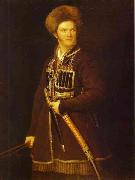 |
Aleksander Orlowski -- Click Here
|
|
(March 9, 1777 - March 13, 1832) was a Polish painter and sketch maker, pioneer of lithography in the Russian Empire.
Orłowski was born in 1777 in Warsaw to a tavern-keeper. In his early childhood he became known as a prodigy and soon Izabela Czartoryska financed his first classes of painting with the notable artist Jan Piotr Norblin. In 1793 Orłowski joined the Polish Army and fought in the Kościuszko Uprising against Imperial Russia and Prussia, but was wounded and returned to Warsaw for further studies, financed by Prince Jezef Poniatowski. He studied with many notable painters of the epoch, among them Norblin, Marcello Bacciarelli and Wincenty Lesserowicz. In 1802, after the Partitions of Poland, he moved to Russia, where he became one of the pioneers of lithography.
Among his works are countless sketches of everyday life in Poland and Russia, as well as scenes of the Kościuszko Uprising and other Polish wars.
|
|
 |
Aleksander Orlowski -- Click Here
|
|
Aleksander Orłowski
Aleksander Orłowski (March 9, 1777 - March 13, 1832) was a Polish painter and sketch maker, pioneer of lithography in the Russian Empire.
Orłowski was born in 1777 in Warsaw to a tavern-keeper. In his early childhood he became known as a prodigy and soon Izabela Czartoryska financed his first classes of painting with the notable artist Jan Piotr Norblin. In 1793 Orłowski joined the Polish Army and fought in the Kościuszko Uprising against Imperial Russia and Prussia, but was wounded and returned to Warsaw for further studies, financed by Prince Jezef Poniatowski. He studied with many notable painters of the epoch, among them Norblin, Marcello Bacciarelli and Wincenty Lesserowicz. In 1802, after the Partitions of Poland, he moved to Russia, where he became one of the pioneers of lithography.
Among his works are countless sketches of everyday life in Poland and Russia, as well as scenes of the Kościuszko Uprising and other Polish wars.
|
|
 |
Aleksander Lesser -- Click Here
|
|
(May 13, 1814 - March 13, 1884) was a Polish painter and art critic of Jewish descent. Lesser specialized in Polish historic and contemporary themes. He was a member of Krakew Academy of Learning and co-founder of Warsaw's Zachęta, the Society for Encouragement of the Fine Arts.
Lesser studied painting at Warsaw University's department of fine arts, as well as at art schools in Dresden and Munich. He was a founder of the history-painting movement in Poland, which is considered a part of the "archeological trend" that existed before Jan Matejko. The trend's purpose was to portray the entire history of Poland in works of art.
|
|
 |
Aleksander Kotsis -- Click Here
|
|
- born 1836 in Ludwinew (now one of parts of Krakew), died 1877 in Podgerze (also a part of Krakew now)- was a Polish painter renowned for his landscapes, portraits and genre depictions of contemporary rustic scenes.
In 1850, he attended the Krakew College of Fine Arts, where he studied under Wojciech Stattler.
|
|
 |
Aleksander Gierymski -- Click Here
|
|
Warsaw 1850-1901 Rome, Brother of Maks Gierymski. He studied (1867) at the Warsaw Drawing Class, then (1868-73) at the Akademie der Bildenden Kenste in Munich under Georg Hiltensperger (1806-90) and Alexander Strehuber (1814-82), and later under Karl Theodor von Piloty. While in Munich he contributed illustrations to Polish, German and Austrian magazines. On a visit to Venice and Verona in 1871 he was especially impressed by the work of 15th-century Venetian artists; this new enthusiasm was reflected in his prize-winning painting of a subject set by the Munich Akademie, a scene from Shakespeare's Merchant of Venice (1872; destr., see Starzynski, pl. 4). After accompanying his dying brother Maks to various spa towns and other locations, he settled in Rome in mid-1874. Two genre scenes from this period, Roman Tavern and A Game of Mora (both 1874; Warsaw, N. Mus.), show the influence of Dutch painting. Gierymski remained in Italy until 1879, mostly resident in Rome. |
|
|
|
|
| | |
|
|
|
|